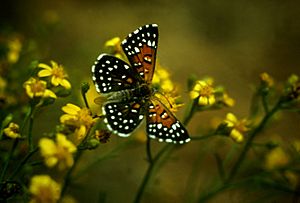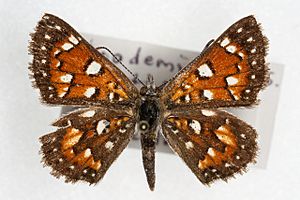Mormon metalmark facts for kids
Quick facts for kids Mormon metalmark |
|
|---|---|
 |
|
 |
|
| Scientific classification | |
| Synonyms | |
|
The Apodemia mormo (also known as the Mormon metalmark) is a type of butterfly mostly found in North America. It belongs to a family of butterflies called Riodinidae. This butterfly is very interesting for scientists who study nature and how living things change over time.
Scientists have found that different groups of Mormon metalmarks look and act differently. This has made it tricky to decide exactly how to classify them. Studies have shown that groups living far apart are different in their genes and how they look. More research is needed to fully understand all the different types of this butterfly.
The Mormon metalmark is found across western North America. Some groups live as far north as Canada and as far south as Mexico. It is the only butterfly from the Riodinidae family that lives in Canada. Most of the 1500 species in this family live in South America.
Some groups of Mormon metalmarks are in danger. The group in Saskatchewan is listed as threatened. The groups in British Columbia and a special type called Comstock Lange are endangered. Protecting these butterflies is hard because they actually need some human activity to help their homes. Things like human and train traffic can disturb the soil. This helps the plants they need to survive grow. But too much human activity can also destroy their homes.
Contents
Where Mormon Metalmarks Live
The Mormon metalmark butterfly lives in the widest area of any North American butterfly in its family. You can find them across western North America. Their range stretches from Sinola, Mexico, all the way to southwestern Canada. They are mostly found west of North Dakota in states like California, Utah, Arizona, New Mexico, and Washington.
In Canada, there are two main groups. One is in British Columbia, along the Similkameen River Valley. The other is in Saskatchewan, in the Grasslands National Park. These Canadian groups are listed as endangered and threatened.
Mormon metalmarks do not live everywhere in these areas. They live in small, separate patches. Studies show that even short distances (like 15–20 kilometers) between these patches can stop butterflies from mixing. This means that groups in different places can look and act differently. Because of this, scientists are still figuring out the best way to classify them.
What Kind of Home Do They Like?
Mormon metalmarks mostly live in dry, desert-like places. These areas must have a lot of their favorite plant: different kinds of buckwheat (Eriogonum). The caterpillars of the Mormon metalmark can only eat buckwheat. So, if you find buckwheat, you will likely find these butterflies.
They can live in many different places like dunes, hillsides, grasslands, and gravelly deserts. This shows they can adapt to different environments. Scientists have found that these butterflies prefer places with lower elevation, south-facing slopes, and soil that is not too rich in nitrogen. They also like steeper slopes, more bare ground, and higher soil pH.
The exact type of buckwheat they eat changes depending on where the butterflies live. For example, the Saskatchewan group likes the branched umbrella plant (E. paucifllorum). In British Columbia, they use Eriogonum niveum. Another type, A. m. langei, mostly eats Eriogonum nudum. Other plants like rabbitbrush (Ericameria nauseosa) are also often found where Mormon metalmarks live. Rabbitbrush can be a backup food source for adult butterflies.
It might seem strange, but some human activity can actually help these butterflies. In Canada, train tracks often run through their habitats. The trains disturb the soil, which helps their host plants grow. Steep, unstable slopes that often erode also create good conditions for buckwheat. Mormon metalmarks are rarely found in flat, undisturbed areas.
What Do Mormon Metalmarks Eat?
Caterpillars
Mormon metalmark caterpillars mainly eat different types of buckwheat (Eriogonum). For the Saskatchewan group, Eriogonum niveum (snow buckwheat) is their main food. In British Columbia, they eat Eriogonum pauciflorum (branched umbrella plant). These plants grow best when the soil is disturbed, like on rocky hillsides. This is why the butterflies are often found in these areas.
Adults
Adult Mormon metalmarks drink nectar from flowers. The branched umbrella plant (Eriogonum pauciflorum) is their main source of nectar. They also use rabbitbrush (Ericameria nauseosus) as a backup. They prefer the branched umbrella plant and only visit rabbitbrush when the buckwheat flowers are dying.
How They Lay Eggs
Scientists have seen different ways that Mormon metalmarks lay their eggs. In California, one type (A. m. langei) lays 2-4 eggs on the older, lower leaves of the buckwheat plant. But in Canada, the butterflies lay single eggs near their host plants, not directly on the leaves. They place them in rocky cracks or soil cracks. This usually happens in the afternoon and takes about 30 seconds.
The difference might be because of the temperature. In colder places like Canada, laying eggs on exposed rocks can help them get more sunlight. This might help the eggs survive. Even so, the eggs must be laid near mature host plants. This is because the caterpillars will need food and protection once they hatch.
Life Cycle
Egg
Female butterflies lay their eggs in small groups, usually 1 to 4 eggs. In Canada, some eggs have been described as "flattened spheres" that are pink and turn purple. Other observations in Saskatchewan describe them as "amber colored" and the size of a "pinhead." How eggs develop might depend on the habitat, temperature, and how much sun they get. More studies are needed to understand this fully.
Caterpillar
Caterpillars hatch from the eggs during winter. They usually stay on one host plant for their whole caterpillar stage. Young caterpillars hibernate (sleep through winter). From June to July, older caterpillars eat buckwheat leaves at night. During the day, they rest in nests made of leaves and silk at the base of the plant.
Pupa
The caterpillar changes into a pupa (like a cocoon) between July and August. The pupas are hairy and mottled brown. They are usually found in leaf litter under the host plant.
Adult
Adult butterflies emerge over about a month, with males appearing a few days before females. These adult butterflies live for about nine to twelve days. Females usually live a little longer than males. During this time, they stay close to their host plant, flying only short distances (up to 50 meters). Females tend to fly a bit farther than males. Both males and females look for nectar to eat.
Reproduction
Mating happens about three days after the butterflies become adults. Females look for male partners, who wait on food plants for them.
Enemies
Parasites
A tiny parasitic wasp called Trichogramma kaykai attacks the eggs of a type of Mormon metalmark found in the Mojave Desert. These wasps lay 3-5 of their own eggs inside each Mormon metalmark egg.
Genetics
Population Genetics
Scientists are still discussing the best way to classify the Mormon metalmark. Because these butterflies live in small, separate groups, it's hard to know how closely related these groups are. One study found that the British Columbia and Saskatchewan groups in Canada are genetically different. It also showed that the British Columbia group has less genetic variety.
Another study also found low genetic variety in the British Columbia group. It showed that butterflies do not often mix between different groups. This means that groups living far apart tend to stay separate. These studies suggest that the groups might be changing over time. More research is needed to make clear decisions about how to classify them.
Subspecies
There are at least twenty named types (subspecies) of A. mormo. Here are a few of them:
- A. m. langei
- A. m. pueblo
- A. m. mejicanus
- A. m. nigrescens
- A. m. arenaria
- A. m. pratti
How Mormon Metalmarks Look and Fly
Appearance
Mormon metalmarks can look quite different depending on where they live. So, there isn't one perfect description for all of them. Generally, their wingspan is about 25–35 millimeters (about 1 to 1.4 inches). Males are usually a bit smaller than females. Females also have three pairs of working legs, while males only use two pairs because their front legs are shorter.
The Canadian butterflies have dark brown wings with white checks. Their bodies are gray, their eyes are green, and their antennae have black and white bands. The base of their front wings has a reddish tint, and the underside of their wings is gray.
Flight
Both the Canadian groups and the endangered A. m. langei have one generation per year. After they become adults, Mormon metalmarks fly for about 30 days. This usually happens from mid-July to September. They are most active in August, about two weeks after the first adults appear.
Adult butterflies do not fly long distances. They mostly stay close to their host plants. They fly to find nectar to eat and to find mates. Their flight is usually short, straight, and fast.
Protecting Mormon Metalmarks
Status
Mormon metalmarks are at risk of disappearing. This is because they have low genetic variety, live in small, unique groups, are spread out in separate areas, and depend on specific habitats. These factors make them vulnerable to things like natural disasters, climate change, and diseases.
Conservation efforts for the Canadian groups started in the early 2000s. For the A. m. langei group, efforts began in 1976 under the US Federal Endangered Species Act.
Habitat Loss
A big worry for people trying to protect these butterflies is habitat loss. Things like building new towns, expanding farms, ranching, and campgrounds can destroy their natural homes. These activities can also break up their habitats into small pieces. Even small habitat areas are important because they can connect different groups of butterflies.
Another problem is when new, strong plant species invade their habitats. If these new plants outcompete the local buckwheat, the Mormon metalmark populations would suffer greatly because they depend on buckwheat. Also, buckwheat plants only live for about 10–15 years. This means new buckwheat plants need to be planted regularly to keep their habitats healthy.
Recovery Strategies
Scientists and conservationists are always working on and updating plans to help these butterflies. For the Lange group in California, efforts started in 1991. They cleared out weedy plants and rebuilt sand and soil mounds. They planted buckwheat seeds in the habitats and fenced off the land to protect it from harmful human activity. For the Canadian groups, experts suggest protecting all habitat patches, no matter how small. They also encourage ways for butterflies from different isolated groups to mix and share genes.
Images for kids


